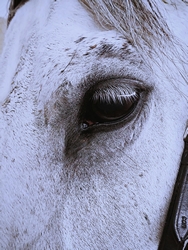RED, WHITE AND BLACK
And the stone they quarried beneath the central island all round, and from beneath the outer and inner circles, some of it being white, some black and some red (τὸν μὲν λευκόν, τὸν δὲ μέλανα, τὸν δὲ ἐρυθρὸν ὄντα). [Crit. 116ab].



While it may seem a rather small detail, the different colours of the stones depicted as making up the buildings in the capital of Atlantis were, presumably, specified for some purpose of Plato's.
But what could it be?
Here, we investigate Plato's statements on the origins of colours from the Timaeus and delve further into the significance of red, white and black in ancient times, both from classical Greece and beyond.
Saddle up!
THE COLOUR THEORY OF THE TIMAEUS

As can be seen above, the colours white, black and red are three of the four primary colours in Plato's scheme from the Timaeus. The fourth, λαμπρός or στίλβω, can perhaps be related to the subsequent depiction of the metallic coverings for the walls around the various circles of the Atlantean capital, particularly the innermost, of "orichalcum which sparkled like fire" [116c - ὀρειχάλκῳ μαρμαρυγὰς ἔχοντι πυρώδεις].
This sparkling effect indeed results from the viewed object being of the "colour" λαμπρός-στίλβω, suggesting that Atlantis' abundant stores of orichalcum compliment the stones of various colours.
The effect of the orichalcum, indeed, reinforces the off-limits nature of the central citadel, discouraging even looking at it on pain of eye damage, as well as bringing to mind the "Allegory of the Cave" from the Republic [7.514a-520a], as a representative of the form of fire.

WHITE HORSE, BLACK HORSE
In terms of white and black, these opposites appear in the Phaedrus myth of the chariot of the soul [246a–254e], representing, respectively, the θυμοειδές ("spirited") and ἐπιθυμητικόν ("appetitive") parts of the soul, with the charioteer representing the λογιστικόν ("logical") element of the psyche.
"White horse" is also the significance of the name of Atlantis' matriarch Leucippe, and the θυμοειδές - which dominates the spirits of the Thracians and Scythians - seeks to achieve glory. In the just soul, it combines with the λογιστικόν to counteract the effects of the ἐπιθυμητικόν, appearing as righteous indignation, though otherwise it leads to great bouts of temper.
Interestingly, the Thracians and - in the form of the Amazons - perhaps the Scythians appear in other stories of Athens' ancient heroics as a troop-rich foe.
Other names in the list of Atlanteans may also shed light on the choice of these colours: Azaes, the elder of the final pair of twins, has a name which can be taken as "scorched", thus representing black, while Eumelus or Gadeirus perchance correlates to red: Heracles' mythical destination of Erytheia - the "red island" - was commonly identified with the Phoenician settlement at Gades.
Furthermore, Homer mentions a "White Rock" [Λευκάς] in the Odyssey [24.11], where it is passed by "Cyllenian Hermes" on the way to the underworld, where he is carrying the souls of the slain suitors for Penelope's hand: -
While the White Rock or Leucas came to be identified with Zmiyinyy ("Snake Island") at the mouth of the Danube - near to which stood another island, Achilleis, where the eponymous hero, mentioned in the Odyssey as being found in the Fields of Asphodel [24.15], was celebrated - Homer appears to have initially intended a western location [Od. 12.81].
Similarly, Poseidon's son Lycus was located in the Isles of the Blest according to Hellanicus' Atlantis. As a brother of Nycteus, Lycus can perhaps be compared to Lycaon of Arcadia, with Nycteus identified with that ruler's younger son Nyctimus. These two perhaps originally represented day and night or light and darkness.
Similarly, the Pleiad Celaeno - said in some sources to be the mother of Lycus - bears a name derived from κελαινός, another word meaning "black" - and one with a significant Indo-European pedigree, being cognate with the Sanskrit काल (kāla). According to Strabo, Poseidon was worshipped in Celaenae in Phrygia Catacecaumene, a region typified by its black stone [12.8.18]. The local myth had it that Poseidon sired the eponym of the city, Celaenus, on another Celaeno, given as the daughter of the Egyptian refugee Danaüs. More rationally, Strabo derives the name from the blackness of the stone.
THE INDO-EUROPEAN SKY DOMAIN
A late source, the Suda, which dates from the 10th century AD, notes the following interesting snippet on the subject of Io, the Argive maiden transformed by the lecherous Zeus into a cow: -
Black, white and red are, along with yellow, three of the oldest colour terms thus far reconstructed for the Proto-Indo-European languages, and the three colours have further significance in early Indo-European cosmology. The Encyclopedia of Indo-European Culture ["Cosmology," s.v. Three Worlds] provides the following description: -
The article continues, covering Haudry's contention that these three skies have been replaced by generational myths, the best-known of which is undoubtedly that of the violent father-son successions which saw the overthrow of Uranus by Cronus and, subsequently, Cronus himself being replaced as king in heaven by Zeus. The colours are represented in this myth by a reading of Hesiod's Works and Days alongside his Theogony: -
This tripartite scheme is also reflected in the social organisation of the Indo-Europeans: for example, a simplified account of the caste system of the Indo-Iranians may be explained in terms of priests (white), warriors (red) and agricultural workers (black).
Similarly, the Old Norse Rígsþula names the three children of the eponymous Rígr (probably meaning "king") in both caste and colour terms. The story goes that Rígr appears at three houses on successive nights, sleeping between the couples before departing. The three sons borne as a result of this action are as follows: -
These three children went on, as indicated by their names, to found lineages who fulfilled those particular functions within Norse society.
THE AXIS MUNDI
The Encyclopedia of Indo-European Culture also goes on to describe the circuits of these skies: -

This certainly tallies with the presentation of the Titan Atlas in the Theogony, variously placed at the gates of Tartarus [744-750] and in the furthest west [517-520], with additional placements apparently in the sea [Odyssey 1.51-54] and close to the Hyperboreans in the north (hence the North Pole perhaps - cf. Polus near Tanagra [Pausanias 9.20.3]) in pseudo-Apollodorus [2.5.11].
APULEIUS' VISION OF ISIS
The notion of Isis (Io) being associated with the colours white, black and ἰάζουσαν in the Suda may have its origins in a vision of the goddess from Apuleius' Metamorphoses [11.1], in which the author describes her raiment and appearance in the following terms: -
URUK AND THE THREE HEAVENS
The monumental gateway to level 15 of the great Sumerian temple at Uruk, the Eanna, which dates from around 3500 BC, makes use of decorative cones in white, black and red. These colours seem to be sacred to the sky god Anu, who was worshipped at the complex alongside Inanna.
Of particular relevance to this circumstance is a description of the uppermost of three heavens, assigned to Anu, whose floor is made up of the luludānitu-stone. This stone is described in Abnu-šikinšu in the following terms: -
Wayne Horowitz, author of the most recent survey of Mesopotamian cosmology, adds: -
Overall, then, the red colour of the stones on Atlantis appear to hint at the island's location in the far west - the domain of the twilight - where Heracles fought Geryon on the isle of Erytheia.
It is also at the furthest western point of Theopompus' continent that one comes to the valley of Anostus, where "it is neither very light nor very dark, the air being dusky intermingled with a kind of red," and where rivers of pleasure and grief flow down into a gulf. The fruit of the trees along the banks of the former confer renewed youth on those who eat of them, another trope associated with otherworlds.
